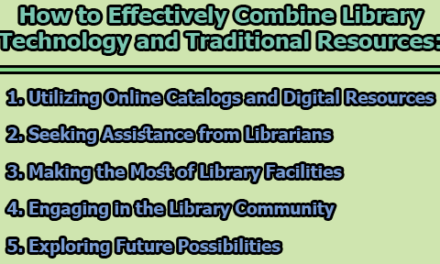Key Steps to Optimize Access to Library Collections:
Organizing a library’s collection is a fundamental aspect of library services that directly influences the user’s experience. Efficient organization makes it easier for patrons to access resources, ultimately enhancing the library’s functionality and usability. In this article, we will explore the key steps to optimize access to library collections.
1. Choose a Classification Scheme: The first step in organizing your library collections is selecting an appropriate classification scheme. A classification scheme is a systematic method of assigning codes or symbols to items in your collection based on their subject, format, or other criteria. The choice of scheme depends on your library’s size, scope, and user needs. Common classification schemes include the Dewey Decimal System, Library of Congress, and genre-based classifications. However, you can also customize or modify a scheme to better suit your specific collection.
2. Create a Catalog: A catalog is a database of records that describe each item in your collection, providing essential information like title, author, publisher, date, and location. Maintaining a comprehensive catalog helps manage your inventory, track circulation, and enables users to search and retrieve items efficiently. Integrated library systems (ILS) or cataloging software can be invaluable for creating and maintaining your catalog. It’s important to follow established standards like MARC (Machine-Readable Cataloging) or RDA (Resource Description and Access) to ensure consistency and compatibility.
3. Label and Shelve Your Items: Once you have classified and cataloged your items, the next step is labeling and shelving them correctly. Proper labeling includes the use of clear and durable labels, such as spine labels, barcodes, or RFID tags. These labels help identify and track items efficiently. Shelving should follow consistent and accurate methods, such as alphabetical, numerical, or color-coded arrangements. Regular checks for errors or misplaced items are crucial to maintaining order.
4. Design Effective Signage: Signage plays a pivotal role in guiding users through the library and helping them locate items. Effective signage should be visible, legible, informative, and consistent. Use simple and clear language, fonts, colors, and symbols to convey messages. Signage includes signs, posters, maps, guides, and labels. Place them strategically and logically throughout the library, making it easier for patrons to navigate the space.
5. Evaluate and Update Your Collections: Library collections are dynamic and require continuous evaluation and updates. Assess the quality, relevance, and usage of items in your collection using criteria like currency, accuracy, demand, condition, and diversity. Implement methods such as weeding out outdated or rarely used items, adding new resources, replacing damaged ones, or relocating materials based on their usage patterns. Engage your users and stakeholders in these processes, soliciting their feedback and suggestions to ensure your collections remain relevant and useful.
6. Provide User Education and Support: User education and support are essential services to help patrons access and use your collections effectively. Offer user education through various channels, such as orientation sessions, workshops, tutorials, or guides. Additionally, provide user support through reference desks, online chat, or phone assistance. It is crucial to maintain friendly, responsive, and knowledgeable interactions with your users.
7. Consider the User Base: Finally, remember that the organization of a library should align with the needs and demographics of its patrons. Libraries catering to elementary students will differ significantly from academic libraries. When organizing and arranging your space, prioritize methods that ensure patrons of all ages and knowledge levels can successfully locate materials.
In conclusion, organizing your library collections for optimal access is an essential aspect of providing valuable library services. By choosing the right classification scheme, creating a comprehensive catalog, labeling and shelving items effectively, designing clear signage, evaluating and updating collections, and offering user education and support, libraries can significantly enhance their usability and accessibility. Furthermore, keeping your patrons’ unique needs in mind ensures that your library’s organization serves its primary purpose – to provide knowledge and resources efficiently to its users.

Library Lecturer at Nurul Amin Degree College










